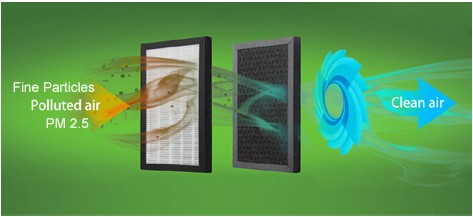PM2.5 is Coming - Are You Ready?
2013-1-16

Believe it or not, PM2.5 has invaded our daily life even before being noticed. Just look at the reference to PM2.5 by the media as below:
"On Wednesday, the Beijing Municipal Environmental Monitoring Center said the density of PM2.5 particulates had surpassed 700 micrograms per cubic meter in many areas of the city….—THE INQUISITR
"An estimated 8,572 premature deaths occurred in four major Chinese cities this year due to high levels of PM2.5, a study has found…-- CHINA ECONOMIC NET
"The Arizona Department of Environmental Quality has issued a health watch for fine particulate matter pollution (PM-2.5) for Monday. As a result, the Maricopa County Air Quality Department has issued “no burn day” restrictions…"EAST VALLEY TRIBUNE
What is PM2.5?
According to the EPA, Particulate matter, or PM, is the term for particles found in the air, including dust, dirt, soot, smoke, and liquid droplets. PM2.5 is also called fine particles or particulate matter 2.5 that refers to tiny particles in the air that are 2.5 microns or less in diameters. Particles can be suspended in the air for long periods of time. Some particles are large or dark enough to be seen as soot or smoke. Others are so small that individually they can only be detected with an electron microscope.
Where does PM2.5 come from?
Fine particles including PM2.5 come from two ways: 1) burning of fuels; and 2) chemical reaction of gases or droplets in the atmosphere.
Burning of fuels happens everywhere, like car, truck, bus and construction equipment where fuels burn inside the cylinder; and other operations where fuels burn directly in the air, such as wood, heating oil or coal and natural sources such as forest and grass fires. Common indoor activities also produce fine particles, such as tobacco smoking, cooking (e.g., frying, sautéing, and broiling), burning candles or oil lamps, and operating fireplaces and fuel-burning heaters (e.g., kerosene heaters).
PM2.5 is also produced by chemical reaction of gases or droplets in the atmosphere from sources such as power plants. These reactions can occur miles away from the original source of the emissions. Because fine particles can be carried a long distance from their source, events such as wildfires or volcanic eruptions can raise fine particle concentrations hundreds of miles from the event.
How can PM2.5 affect my health?
Particles in the PM2.5 size range are able to travel deeply into the respiratory tract, reaching the lungs. Exposure to fine particles can cause short-term health effects such as eye, nose, throat and lung irritation, coughing, sneezing, runny nose, shortness of breath. Exposing to PM2.5 can also worsen medical conditions of asthma and heart disease. Scientific studies have revealed that long term exposure to fine particulate matter may be associated with increased rates of chronic bronchitis, reduced lung function and increased mortality from lung cancer and heart disease. People with breathing and heart problems, children and the elderly may be particularly sensitive to PM2.5.
Are there ways to fight against PM2.5?

When outdoor levels of PM2.5 are high, staying indoors may reduce your exposure to PM2.5. However there are significant indoor sources of PM2.5, levels inside may not always be lower than outside. The solution is to reduce indoor PM2.5 level while staying indoors. Driving the air through filters that screen out fine particles is the way. You can buy filters with activated carbons and force the air the flow through it with a fan, or you can buy a product such as a computer case with air filters. While the device is operating indoors the PM2.5 levels drops. Luckily there are existing products on the market already. The China manufacturer, Golden Field, has launched 2 PC case models with carbon filters, the Pure Flow 7629 healthy caseand the Air Purifier case 8526. Besides avoid strenuous activity in areas, burning candles indoors or open burning outdoors, where fine particle levels are high. Except that, limiting indoor and outdoor activities, and inhale less air is another way to reduce the harm of PM2.5.




